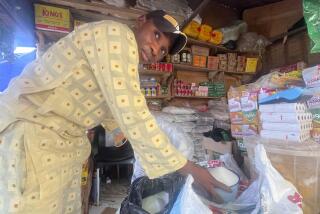Prices Expected to Rise Sharply : Brazil Drought Hits Coffee Crop
- Share via
RIO DE JANEIRO — Brazil’s coffee crop has been reduced at least 43% by severe drought in growing areas, according to an official crop forecast, and the retail price of coffee is expected to rise sharply both in Brazil and in the United States.
The official estimate of 16.7 million bags (of 132.3 pounds each) was made public Monday as the Brazilian Coffee Institute, a state agency that regulates coffee trading, set a minimum export price of $2.80 a pound for this month and next.
The new minimum is virtually double the price that had been in effect. The Brazilian minimum closely parallels coffee prices in New York and other commodity exchanges, where prices have been soaring.
The prospect for U.S. coffee consumers is for a substantial rise in retail prices in the months ahead. In Brazil, the retail price has already gone up 50%.
The price of coffee in U.S. supermarkets hasn’t yet been affected by the latest reports of a looming shortage, analysts and industry sources said. However, at the wholesale level, most major U.S. coffee roasters already have raised their prices significantly during the last six weeks.
General Foods, based in White Plains, N.Y., has raised the wholesale price of its Maxwell House brand by 75 cents a pound since December. New York-based Chock Full O’Nuts said it has raised the wholesale price of its coffee by $1.25 a pound during the last six weeks.
The price of coffee on the New York Coffee, Sugar and Cocoa Exchange rose by more than 11 cents a pound on Tuesday to $2.7345 a pound. Bill O’Neill, director of research at Rudolf Wolff Futures in New York, said he expects prices to go over $3 and possibly as high as $3.50 a pound.
“There is going to be a significant increase in the retail prices very shortly,” said Howard Leitner, chief financial officer of Chock Full O’Nuts. He declined to say how higher prices would affect his company.
Brazil’s next official estimate of the coffee crop is due in February, and some forecasters say the year’s crop may actually be less than 14 million bags. Market analysts in the United States said Brazil may have inflated its crop estimate Tuesday to avoid panic in the market and an even steeper run-up in price.
“Within coffee trading circles, no one feels these numbers are realistic,” O’Neill said. He said Brazil’s coffee production would more likely range between 10 million and 12 million bags.
Frost Could Mean Shortage
“We’ll have a better idea at the end of January, when we see how many buds flower,” said Warren Muller, West Coast manager for Acli Coffee, a major coffee importer.
Coffee plants flower near the end of January and produce green coffee buds, which are harvested during May, June and July--just as winter arrives in Brazil’s coffee growing regions. Muller and several other importers said a frost during the harvest season could lead to a shortage of coffee.
“That’s the great unknown,” Muller said. “We haven’t had a frost in quite a few years, so if you look at it that way, we’re due for one.”
A deep frost in August, 1975, reduced Brazil’s 1976 harvest by two-thirds. Coffee prices more than doubled in 1976 as a result, and Americans drank less coffee. Consumers should be prepared for a repeat of that experience, O’Neill said.
For southern Brazil, the drought is a major disaster, increasing inflationary pressures and creating rural unemployment at a time of widespread land conflicts between peasants and large ranchers.
Before the drought, the 1986 coffee crop had been estimated at 27 million bags, about the same as last year. A large carry-over of unsold coffee from last year will prevent any shortage for export, but speculative buying has pushed up the price for future deliveries.
Brazil, as the world’s largest coffee producer, is the main beneficiary of higher prices. With exports of about 19 million bags, from stocks as well as its new crop, the Finance Ministry has estimated export earnings from coffee this year at $3.3 billion, compared to $2.4 billion last year. This means that Brazil’s overall trade surplus, which was $12 billion last year, will not be adversely affected by loss of coffee production.
But the drought has also damaged corn, soybean and rice plantations, killed 500,000 head of cattle and reduced milk output. All this contributed to a 16% rise in domestic food prices in December. Food prices have been the main factor in rising inflation, which accounted for an increase of 233% in the cost of living last year.
To meet the threat of food shortages and further price increases, the authorities are planning to import at least $1 billion in foodstuffs in the first half of this year.
But the drought, affecting the major agricultural states of Rio Grande do Sul, Parana, Santa Catarina and Sao Paulo, is not over. In some places it has not rained for 90 days.
Juan de Onis reported from Rio de Janeiro and Denise Gellene from Los Angeles.
More to Read
Sign up for Essential California
The most important California stories and recommendations in your inbox every morning.
You may occasionally receive promotional content from the Los Angeles Times.













